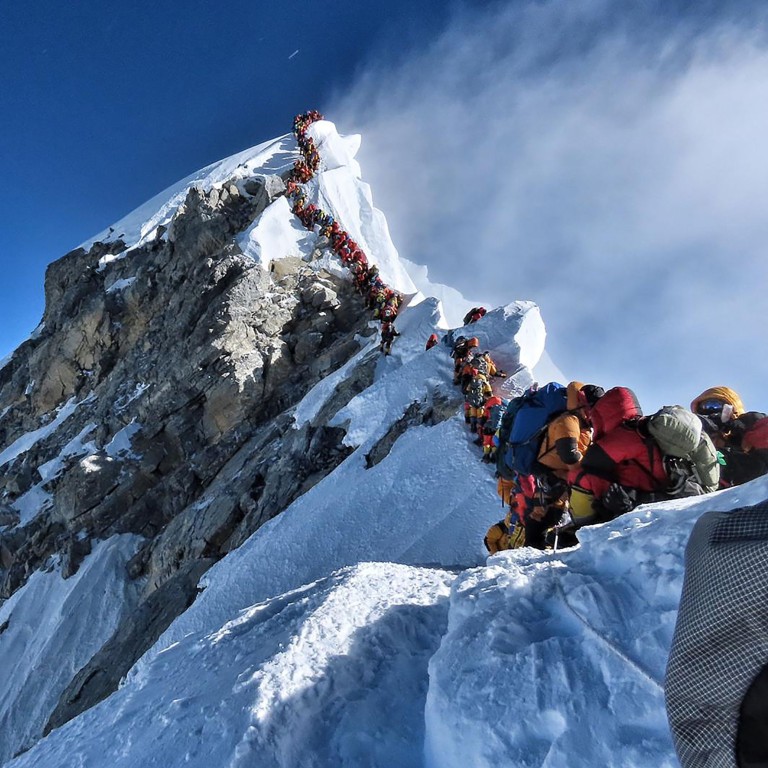
The real tragedy behind the Everest traffic jam: climate catastrophe and the capitalist malaise at the heart of contemporary life
- Everest is one in a long list of indigenous holy sites that have become commodified and sold to the wealthy. While these experiences are packaged as a chance to get closer to nature, the underlying theme is of conquest
The iconic photograph, taken by climber Nirmal Purja, showing a queue of hundreds of people waiting their turn to reach the summit of Mount Everest, took the international media by storm. The photo captures both the danger and the absurdity of so many paying so much for adventure atop the roof of the planet.
This narrative targets the usual suspects – greed, inefficiency, corruption and inexperience. Yet, if one reflects more deeply on the photograph, a different and more disturbing interpretation emerges.
This alternative narrative begins with the reminder that Everest is a holy site for millions of ethnic people who live in the high-altitude Himalayas. To the ethnic Sherpa populations, who live in the immediate vicinity of Everest, the mountain and the surrounding terrain have always symbolised the interdependence of society and nature.

While it is true that Sherpas have become a part of the Everest tragedy, it is a reluctant participation, the same sort of colonial seduction that has trapped marginalised indigenous communities around the world into positions of servitude in relation to those who control powerful political and economic forces.
The second part of this more disturbing narrative is the all-encompassing power of global capitalism. Capitalism has commodified everything, transforming humans, nature, the landscape and, indeed, life itself into a value calculated within the framework of profit and loss.

Nature becomes an object to be consumed and paid for; something to be used by a select few humans to compensate for an alienated existence that disables our ability to see life as inherently adventurous. Moreover, the adventure tourism industry is infused with the conquest mentality. White-water rafting, wilderness skiing, hang-gliding off mountains, rock climbing and scaling mountain peaks like Everest are described and experienced within the trope of conquest.
Brash or brave? Climber ditches team to summit ‘savage mountain’ solo
Capitalism has not only commodified nature, but has framed it as an enemy to be dominated. This only widens the nature-human divide.
An estimated one-third of the Himalayan ice fields could disappear by the year 2100. Increased landslides, drought, erratic and unpredictable weather will result. More than 14 major river systems originate in the Himalayas, providing a lifeline for several billion people in Nepal and India who depend on the complex Himalayan ecosystems for their survival.
The existence of those people becomes more tenuous daily. The warming of the region is the proverbial canary in the coal mine, a harbinger of an escalating disaster for the region and the entire planet.
The climate catastrophe, produced by global capitalism, is already destroying the lives of vulnerable peoples in the Himalayas, the whole of Nepal and much of the rest of the world.
The forces of ever-expanding capital accumulation, insatiable consumption of Earth’s resources and the commodification of everything on the planet are creating a dystopian future. Conquest and the nature-culture divide have always been embedded into the ideology of capitalism and are nowhere more present than in the adventure tourism assault on Everest.
This is the tragic backstory of the recent events on Everest that Purja’s photograph unintentionally captures. The image is a perfect representation of what is terribly wrong at this historical juncture. While climate catastrophe looms over the planet and Everest, hundreds of people pay, what for most is a small fortune, to stroke their individual egos and “conquer” nature.
The financially privileged few, purchasing a holiday package that promises adventure and spectacle, exemplify the ego-fed, commodified blindness of the so-called industrialised world. Talk about Nero fiddling while Rome burns.
This tragic and ugly reality flies in the face of the inherent majesty of Everest and the Himalayas. Yet, it must be emphasised and digested over and over again until humans accept that we are a part of nature, not its overlords.
Gregory Reck is research professor of anthropology at Appalachian State University, US. He has conducted sociocultural research in rural Nepal, Mexico and India. Dinesh Paudel, a native of Nepal, is associate professor of sustainable development at Appalachian State University. He has conducted extensive research on development and climate change in Nepal


